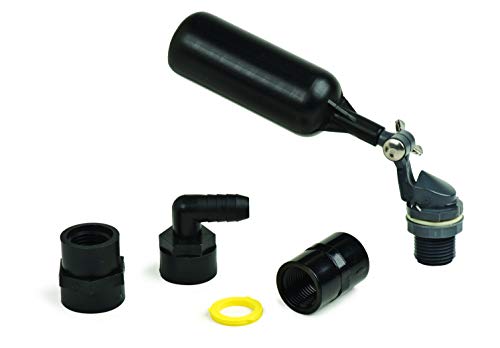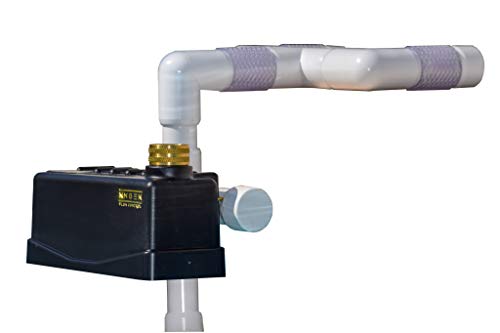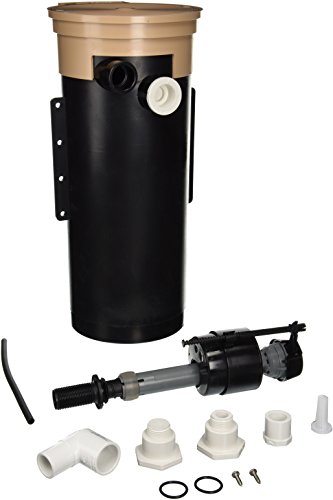Method 1: Pond Auto-Fill Valve (Float Valve)
Installation difficulty: Very Easy (No power required)
The simplest option for raising a ponds water level is with an auto-fill valve, being particularly good for pond owners on a budget due to its cheap purchase price. Autofill valves, float valves, or classically “ballcock” valves, are a popular option for smaller ponds and for use within skimmer systems to keep pumps from running dry.
The valves’ mechanism is just as simple as the design, and works using a basic float device which rests on the surface water of the pond and opens or closes a valve door depending on the surrounding fluid level. If water levels drop, the float will sink and this will release the valve door and allow water to flow from your hose pipe connected to the intake. As water levels increase, the float begins to to rise again, slowly closing the valve door when it reaches the desired water level.
A very similar type of valve can be found in many toilet systems around the world, allowing water to be drained when the toilet is flushed, and providing an influx of new water as the float rises to the top of the toilet chamber. The name “ballcock” valve originates from the fact that many of the older models would make use of balls as float devices, but modern auto-fill valves now come in a range of different shapes and designs.
No mains socket power is needed or complicated plumbing, and most are very easy to install even for beginners to the hobby. Your garden hose can be connected directly to the intake, and the valve would then control when water is needed in the pond based on the current volume and position of the float. Since the water is coming straight from your mains supply, we recommend installing an activated carbon attachment to the end of your hose before the intake to help remove harmful chlorine from the water.
Method 2: Mounted Pond Water Regulator
Installation difficulty: Easy (No power required)
- Don't risk pool overfilling with cheaply made autofillers that max out at 100% capacity at 55 psi—upgrade to the Staypoollizer NxGen,...
- Nxgen Stainless Steel water inlet capable of handling the harsh chemicals and environment associated with swimming pools. Eliminating water...
- Performance and durability enhancements are just the start. The Staypoollizer 2.0 has increased stability and weight. Capable of adapting to...
A slightly more advanced device which uses a specialized float valve inside a leveled chamber which keeps water at a more constant point. Whereas a basic float valve will literally float on the surface water and move with the current, which can be trouble some if you have a strong pump, this type of device is secured on the side of the pond embankment.
Although designed for water regulation in pools, it would work fine for use in fish ponds as the underlying technology is still incredibly simple. The main float chamber is positioned in the pond just below the ideal water line measurement, and can be extended using the framework included. Inside this chamber is a float valve which is more accurate than a basic float as it’s protected from disturbance from surrounding weather and water flow. The float chamber is connected to the framework, and then the framework is securely neatly on a pond embankment and positioned accordingly.
Once the device is in place, you connect your garden hose or mains supply line directly to the float chamber via the primary intake. After this is done, the device functions very similarly to a basic auto-fill valve, releasing water into the pond when the level drops, and closing the valve when water rises again. The benefit of this type of installation is that it’s neater, and provides a much more accurate water level measurement, especially in strong flowing conditions.
Everything is included to get things set-up, and no extra pipework, fitting, or mains electricity is required. As before, since water is coming from your mains supply we recommend a heavy duty carbon catalyst on the intake hose to remove harmful chlorine.
A downside is that it’s a little more difficult to hide in comparison to a basic float valve or below-ground installation, but it’s still fairly small so can be hidden with stones and foliage. Overall, a good choice for those who want a little extra flow control at a decent price point without the need of complex installation.
Method 3: Below-Ground Auto-Fill Canister
Installation difficulty: Advanced-Expert (No power required)
- Available for standard in-ground and vanishing edge pools
- Prevents equipment damage due to low water levels
- No electronic controls
If you’re looking for a more permanent solution which is much more discreet than regular auto-fill valves and mounted water regulators, you can consider a below-ground auto-fill canister. These type of automatic water re-fillers are fitted in a similar fashion to a skimmer box, which requires a below-ground install and extra pipework for operation.
A hole will need to be dug within close proximity (<10 foot) of the pond, and your mains water supply connected to the supply line of the intake. An equalizer pipe is then plumbed through the pond embankment and into the pond itself, which works to refill water after levels drop too low. The canister needs to be installed in-line with the pond surface water which acts as the baseline for both canister and pond, and when water in the pond drops below the canister level, more water is added through the equalizer line.
Similar to other methods here, a float valve is used on the mains supply intake inside the canister which works to open and close the supply line and top-off water when levels drop. Unlike older ballcock-style valves, many of these newer canister devices include newer float valves for more accurate measurements and better durability, meaning less replacements in future.
The downside of these style of autofill devices is that they require much more in the way of installation in comparison to a basic float valve, and work best for new pond builds where you still have room to work. However, if you have plumbing experience and enjoy taking on bigger projects, these are no more difficult to install than most skimmer boxes, requiring no mains power but still direct connection to a water supply.
Method 4: Electronic Water Control Alarm System
Installation difficulty: Easy-Advanced (Mains power required)
Probably our favorite method of maintaining constant pond water levels, and from personal experience, one of the best long term investments for ponds constantly needing top-offs. Electronic water control systems make use of a sophisticated control box, water probe, and electronic anti-siphon valve to maintain efficient water levels with little in the way of installation requirements.
The control box is fitted inside your home, or on an outer wall, and can function up a large distance away from the pond. The control box gauges information on the current water level and whether or not the system is currently operational, as well as a sensor alarm which indicates if water levels are becoming low. The sensor itself works via a small electronic probe which is added to the pond at the desired water level, and when water drops below the probe height, the control box will send a voltage signal to the electronic valve.
The valve will be connected to your mains water supply or an irrigation system, and once it receives a voltage signal from the control box it will release water down a dedicated line which needs to be connected to the pond. Once the water level rises and comes into contact with the probe, the control box sends another signal and the valve will automatically close itself. We find the best placement for the main supply line would be directly into a skimmer box, as it makes the refilling of water much more discreet and quiet, but it will work pretty much anywhere.
This type of auto-fill device can be fitted alongside your current pond framework, and does not require any digging or extra labour, which is great. You will need access to both a water supply and your mains power supply, so setting up the device will require some knowledge in both plumbing and electrical. However, the installation instructions on most models (pictured) are very helpful, so should not be a problem for those willing to learn or with some DIY experience. For more information, here is a useful video providing an overview of these kinds of devices by an installation expert.
For those who want an even more discreet solution, you can also now get wireless electronic water control systems, which work in a similar fashion but require no extra wiring between probe and valve to the control box.
Maintaining Pond Water Levels – Why is it Important?

Although it may appear that our ponds have adequate water, sometimes a drop in volume can be so gradual you won’t even notice a change! Unless you’re regularly monitoring your water levels against a fixed point, or using a water meter, it can be very difficult to determine if you have a constant volume or not. In wildlife ponds without fish, drops in water levels are not a major concern and most pond owners can simply wait for heavy rainfall to replenish their supply.
However, if you have a heavy fish stocked pond, a drop in water volume means there will be less dissolved oxygen content available. This drop in oxygen can can lead to less efficient filtration (aerobic beneficial bacteria), worsening water quality, and more stress placed on koi and goldfish as they struggle with oxygen requirements. As well as this, a lower water level will expose the roots of plants which can interfere with growth, and also cause more UV light to penetrate the water, which can cause blooms in algae and nuisance weeds.
With that said, small drops and rises in water levels are a natural part of pond keeping and aren’t always something to worry about. Natural evaporation is a constantly occurring phenomenon, and in most climates it will strike a balance with rainfall to ensure water doesn’t drop too low.
However, if you live in a much dryer climate, or have particularly hot summers, the rate of evaporation and water loss can easily exceed it’s natural replenishment – and this is when you will start having problems! Major drops in water volume can also be caused by other factors, such as leaks, which can cause lots of problems for fish if the cause isn’t fixed in good time.
Relying on sight to determine if your pond water is dropping is not always accurate, and if you experience a lot of natural evaporation, we recommend installing an auto-fill solution to keep on top of the dropping volume. As well as providing a constant volume so you don’t need to constantly check, it also allows you to be away from the pond for extended periods (i.e. vacation) without the worry of water levels falling dangerous low.
Why is my Pond Water Level Dropping? (Common Causes)
1) Natural Evaporation (Summer)
Regardless of your location in the world, all ponds will experience some form of natural evaporation which will cause water levels to lower over time. For most of us, this drop in water is mostly negligible, and will be restored naturally through rainfall as the weather shifts. However, in summer months when the temperature of the air is much higher, water levels in ponds can drop as much as 2 inches (5 cm) within a few days, which can lead to problems if the water isn’t topped off. If you live in an area with a very warm and dry climate with mild winters, you can expect much more evaporation to take place in comparison to a colder or wetter climate.
2) Water Feature Overspill (Fountains/Waterfalls)
Another possible cause of drops in water level is due to the overspill of water into the surrounding environment. This usually happens when a water feature, such as fountain or waterfall, is splashing water outside the main pond system which leads to a reduction over time.
Even if you cannot physically see water being deposited outside the pond, it can still be lost to evaporation as it leaves the outlet of the fountain or waterfall and becomes heated in the warmer air. In-fact, one of the largest contributors to large drops in water level are water features running in summer months, as the water is spread much more thinly and evaporates far more rapidly into the atmosphere in comparison to the pond surface.
3) Pond Liner & Equipment Leaks
Finally, if you’re seeing a steady decrease in water levels and you’re sure evaporation isn’t the cause, you may have a leak in the pond liner or there could be a leak in the ponds plumbing framework. Although many pond liners, especially rubber, are highly resistant to tearing, no material can last forever and all liners will eventually begin to weaken over time.
However, from experience, the most common time to see pond liner damage is after installing new equipment, such as skimmer boxes, as rips can easily happen during installation. If you have recently installed a new skimmer, submersible pump, or drainage system, be sure to double-check the pond liner around the pipework to ensure all edges are sealed. Leaky pipes are also a common cause for water levels decreasing, but luckily these are easy to spot and fix with a quick maintenance check of plumbing framework.





I have a rubber-lined koi pond where the water level is regulated via a float valve which failed recently causing me to waste a lot of water when the pond overflowed. Can you recommend a wireless, outdoor, water level monitor that will notify me if and when the water level reaches a certain point?
Hi Martin,
Sorry to hear about the valve failure. The same has happened to me in the past, so I know the frustration!
In terms of wireless water level control products, they’re still somewhat uncommon in the hobby, but most products advertised for swimming pools will work just as well for garden ponds. Two options with alarm sensors are below:
LevelSmart Wireless Water Level Control – https://amzn.to/2J5p9nw
Jandy Wireless Water Level Control – https://amzn.to/2KYxZ8m
we have a upper pond, waterfall and lower pond and filter system. The water level stays fine while running for days but if I turn off the pump at night the water level drops when you turn on the pump again. Neither pond has a leak. I had the pipe checked and the waterfall lining and nothing. It seems like water is dumping from the filter or lift pipe but nothing shows up. My neighbor did complain about water in his yard but we can find nothing. Is there a back flow or something
Hi David,
Hmm, that’s a tough one. Have you checked the main pond liner for leaks? If the water level always lowers to a specific point, you could have a small tear present. The other thing I’d suggest is turning off the water fall feature and just letting the rest of the system run. Even though it often makes no sense, I can’t count how many times a waterfall has been the culprit when it comes to a leaky pond. Often it’s a mix of poorly fitted lining around the feature, leaky connections, or splashing over the back/sides of the feature itself.
With that said, not all leaks are easy to find and sometimes the only way to find the source is by systematically checking the whole system from one end to the other – pipes, fittings, and water features included. I feel that a good start would be isolating just the pump and main filter and letting them run, as this would allow you to determine if the waterfall feature is the cause or not.
I suspect that the issue that when you have the system on, the upper pond water level is some number of inches above the waterfall. If both ponds are full, when you turn off the pump, the inches of water in the upper pond that feed the waterfall when the pump is on will drain into the lower pond, and likely overflowing the lower pond. When you turn on the pump, the water in the lower pond is moved back up to the inches of water in the upper pond needed to operate the waterfall.
The end result is you will now have a lower water level in the lower pond.
Should be easy to test –
I need help! I have a 4 level water/pond feature. At highest level (I call top of feature) I have water pumping from the lowest level via independent pump. That water falls to second level, then to the third level (300 gal). To get flow of water to bottom level, (175 gal), I had to I use a prefab spillway with indepen pump. . Both bottom two have fish, 300 gal has external filter system and the smaller one as a submursible filter.
Wheew! after all that my challenge is that the water flow from the second level to the third and then the third to the fourth aren’t always the same so I’m constantly needing to tweak the spillway pump to keep water levels. I want to leave the pumps flowing all the time but if I don’t babysit them then one pond is overflowed one pond is under filled.
What can address this so water levels in both ponds remain more constant? Maybe a water level control on the spillway??
I have a stream and three falls from one pump and sump, I’m losing water 4inches in couple of days ,, I have changed the sump as this was the, I thought was the main reason, while doing this I checked liner highs and lows which all are good, my stream is 31ft long heavy rain fall over fills, but still loses… any other things worth checking ?
Hi. I have a strange issue with a new pond. Due to the slope on in the garden, we have had to put our stream and waterfall at the top of the slope and the pond at the bottom. It all works fine. But when it rains the water level raises and the excess water floods out onto the lower part of the garden as there’s no where else for it to go.
I am looking for an automatic solution to check when the water level rises to turn on a pump to pump the excess water out to a drain, or better still, open a three way value, connected to the main pump, to divert the waterfall flow to the drain (saving me another pump in the pond).
I would appreciate any tips or recommendations
FWIW, I wouldn’t be happy with an automatic stream divert to a drain unless you had a secondary safety feature cutting the pump in the event the pond continues to empty.
It is great to see that I am not the only one with weird pond/level arrangements 🙂
One thing I have found is that waterfalls (mine are made up of concrete ‘leaves’ I poured and have in 3 tiers) often get weird leaks’ under the lips. What I mean is that the water will flow over them and sometimes (if the flow is lower) some water will flow up under the lip and leak out. I find this hard to control. I am thinking of using glue to put a bit of pond material under the lip and drape it forward a bit, creating a catchment that would redirect water into the lower level. Anyone have any ideas?
Hello, I had an issue with the gasket on my filter. We had a small leak, that we were not aware of, and the pump kept pumping and water kept leaking. The next morning the water level was way down. Is there an alarm or auto shut-off that would trigger the pump to shut off when the water level gets down to a certain point?